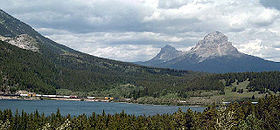- Crowsnest Pass
-
Crowsnest Pass 
Crowsnest Lake, Crowsnest PassElevation 1,358 m (4,455 ft) Traversed by Crowsnest Highway
Canadian Pacific RailwayLocation Location Crowsnest Pass,  Alberta / Sparwood,
Alberta / Sparwood,  British Columbia,
British Columbia,  Canada
CanadaRange Canadian Rockies Coordinates 49°37′57″N 114°41′33″W / 49.6325°N 114.6925°WCoordinates: 49°37′57″N 114°41′33″W / 49.6325°N 114.6925°W Crowsnest Pass (sometimes referred to as Crow's Nest Pass, in French passe du Nid-de-Corbeau) is a high mountain pass across the Continental Divide of the Canadian Rockies on the Alberta/British Columbia border.
Contents
Geography
The pass is located in southeast British Columbia and southwest Alberta, and is the southernmost rail and highway route through the Canadian Rockies and the lowest-elevation mountain pass in Canada south of the Yellowhead Pass (1,130 m); the other major passes, which are higher, being Kicking Horse Pass (1,640 m), Howse Pass (1,530 m) and Vermilion Pass (1,680 m).
Crowsnest Pass comprises a valley running east-west through Crowsnest Ridge. On the Alberta side, the Crowsnest River flows east from Crowsnest Lake, eventually draining into the Oldman River and ultimately reaching Hudson Bay via the Nelson River. Summit Lake on the British Columbia side drains via three intermediary creeks into the Elk River, which feeds into the Kootenay River, and finally into the Columbia River to the Pacific.
Transportation
The Canadian Pacific Railway built a line from Lethbridge, Alberta, to Kootenay Landing, British Columbia through the Crowsnest Pass between 1897 and 1898. This line was built primarily to access mineral-rich southeastern BC via an all-Canadian rail route, and to assert Canadian (and CPR) sovereignty in an area that U.S. railroads were beginning to build into. It also opened up coal deposits in the Elk River valley which were important to mineral smelting operations and assisted the CPR in its conversion of locomotives from wood to coal. The CPR sought and received construction funding from the federal government, partially in exchange for a freight subsidy on prairie farm exports and equipment imports which came to be called the "Crow's Nest Pass Agreement".
"The Crow Rate", as the subsidy agreement came to be referred to, was eventually extended from CPR's Crowsnest Pass railway line to apply to all railway lines in western Canada, regardless of corporate ownership or geography, creating artificially low freight rates for grain shipments through the Great Lakes ports. The rate also correspondingly limited industrial growth in the western provinces as it was cheaper to produce items in eastern Canada and ship them west under the Crow Rate. This subsidy was finally abolished in 1995.
The Crowsnest Highway operates as Highway 3 in both provinces and runs through the pass parallel to the CPR line, as does an oil pipeline.
Natural resources
The Crowsnest Pass area on both sides of the provincial boundary is rich in coal deposits, which were quickly developed after completion of the rail line. All the mines on the Alberta side were closed by the end of the 20th century as cheaper and safer open-pit mines opened on the British Columbia side of the pass. Some logging and oil and gas exploitation also occurs in the area, and a sulphur plant has been in operation there for several years. Tourism based on the natural and historical resources of the area remains underdeveloped.
History
- Crowsnest Pass is the richest archaeological zone in the Canadian Rockies. The oldest relics are stone tools found on a rock ridge outside Frank, Alberta, from the Clovis culture, 11,000 years before present. Other sites include chert quarries on the Livingstone ridge dating back to 1000 BC.
- 1800: Members of David Thompson expedition enter the pass.
- ca. 1850: Crow Indians dispersed from area by Blackfoot Confederacy.
- 1860, 1873: Michael Phillips (Hudson's Bay Company) traverses pass, reports coal deposits.
- 1881: first surveys by Canadian Pacific Railway.
- 1897: CPR enters into farm export subsidy agreement for freight rates in exchange for financing of railway line between Lethbridge, Alberta, and Nelson, BC. Crow's Nest Pass Coal Company commences operations in British Columbia.
- 1898: CPR opens the railway line, 10th siding (later Blairmore, Alberta) established. Settlement of Fernie, British Columbia, established.
- 1900: the Frank Mine opens and the new town of Frank, Alberta, is established. Other coal mines and towns spring up between 1900 and 1919.
- 1902: explosion at Coal Creek mine kills 128 men.
- 1903: the cataclysmic Frank Slide occurs on the north slope of Turtle Mountain; 82 million tonnes of limestone crash down and partially bury the town of Frank, killing approximately 70 of the town's 600 residents.
- 1904: Fernie, British Columbia, incorporates.
- 1908: forest fire destroys Fernie (pop: 6000), which soon rebuilds.
- 1914: an explosion in the mine at Hillcrest kills 189 men, Canada's worst mine disaster.
- 1916–1923: Prohibition in Alberta; "rum-running" across the provincial boundary.
- 1920: Train robbery and shootout at Bellevue Cafe.
- 1923: 'Emperor Pic’ (Emilio Picariello) and Florence Lassandro hanged for shooting a police constable; first woman hanged in Alberta.
- 1932: Highway 3 built as a Great Depression project.
- 1966: Communities of Michel, Natal, and Sparwood amalgamate into the District Municipality of Sparwood, British Columbia.
- 1979: Communities of Coleman, Blairmore, Bellevue, Hillcrest, and Frank amalgamate to form the Municipality of Crowsnest Pass, Alberta.
References
- Crowsnest and Its People, Crowsnest Pass Historical Society, 1979.
- Crowsnest and Its People Millennium Edition, Crowsnest Pass Historical Society, 2000.
External links
- Official Website of The Municipality of The Crowsnest Pass
- Pass History
- Pass Timeline
- Crowsnest Railway Route
- Frank Slide Interpretive Centre
- Crowsnest Pass
Categories:- Crowsnest Pass, Alberta
- Mountain passes of British Columbia
- Mountain passes of Alberta
- Great Divide of North America
- Canadian Pacific Railway facilities
- Rail mountain passes of Alberta
- Rail mountain passes of British Columbia
- Regional District of East Kootenay
- Borders of British Columbia
- Borders of Alberta
Wikimedia Foundation. 2010.
